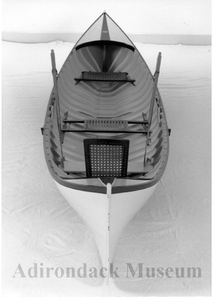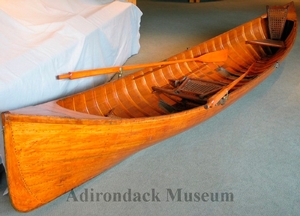What is a Guideboat?
There was no “invention” of an Adirondack guideboat—rather, the Adirondack guideboat evolved from a need for an efficient, lightweight mode of transportation through the waterways. Because of their unique structure and their exclusiveness to the Adirondacks, guideboats are difficult to define. Different people define guideboats differently, so for the purpose of this website we are using the definition of Adirondack scholars Kenneth and Helen Durant that is the accepted definition by the Adirondack Museum. They highlight five necessary structural components of a boat to make it a guideboat:

1) A narrow wooden boat, pointed at both ends, with “sawn ribs of natural crook erected on a flat, elliptical bottom board” (Durant, 1980).
2) A smooth planked surface with ¼ inch spruce or cedar boards on the outside of the boat
3) Can be carried by one man, as indicated by a notched yoke
4) The middle seat is removable, with no fixed thwarts
5) Square oar looms, oar handles cross at mid-stroke
 The ribs of the boat, as shown in the image on the right, are carved from the trunk of a single spruce or cedar tree and form the foundation of the hull. The ribs are attached to a flat bottom board before the smoothed planks are attached to the ribs. A yoke is attached across the center to allow the boat to be carried on a single person’s head and shoulders. The seat lies near the yoke, and is removable to allow for easier transport. The boat’s oars are attached to the boat’s oarlocks so that the rower can briefly let them go to adjust gear, fish, hunt, etc. The oars have large square looms near the handles that help balance the boat’s weight and prevent the oars from sliding out of the oarlocks.
The ribs of the boat, as shown in the image on the right, are carved from the trunk of a single spruce or cedar tree and form the foundation of the hull. The ribs are attached to a flat bottom board before the smoothed planks are attached to the ribs. A yoke is attached across the center to allow the boat to be carried on a single person’s head and shoulders. The seat lies near the yoke, and is removable to allow for easier transport. The boat’s oars are attached to the boat’s oarlocks so that the rower can briefly let them go to adjust gear, fish, hunt, etc. The oars have large square looms near the handles that help balance the boat’s weight and prevent the oars from sliding out of the oarlocks.
Durant’s definition is based on the unique construction style of a guideboat. The construction is very specific, but it took many years of development and refinement before a standard guideboat model was accepted. The definition says that a guideboat must be made of spruce or cedar, because those were the lightest available materials available in the heyday of guideboat building. Modern guideboat builders have access to lighter materials like Kevlar, and even if Kevlar is used to create a boat with the exact same design of a traditional guideboat, there is much debate among guideboat builders and historians as to whether or not a kevlar boat can truly be considered a guideboat.
The beginning of the guideboat in the Adirondacks was believed to be somewhere between 1825 and 1835, and it was not until 1890 that the guideboat became extremely popular throughout the region. The beginning of the guideboat is hard to pinpoint, although there is a common story of a Native American and an Adirondack guide Mitchell Sabattis creating the first ever “guideboat” in Long Lake (Durant, 1980). In fact, although this definitely was one of the earliest known guideboats, Sabattis’ vessel was probably a combination of ideas borrowed from other builders throughout the Adirondacks.
 Before these lightweight boats were coined the “guideboat”, boat builders in the Adirondacks were trying to make their boats as light as possible so trappers and hunters could carry them on their own. Early travelers in the Adirondacks described a unique “Adirondack skiff” that was lighter than most other boats. Nat Foster, a famous hunter and trapper in the Adirondacks, was using a boat in 1827 that he could carry his skiff on his head and shoulders until he was 60 years old (Bond, 1995). This was the beginning of a trend towards creating a boat as light as possible to be used by the trappers and hunters needing to carry gear for long distances through the mountains of the Adirondacks. The lakes and streams through the mountains are infamous for the long stretches of land between them—known as “carries” in the Adirondacks—which travelers would need to transport their gear over, sometimes for up to two miles. Traditional heavy skiffs were not feasible for one person to carry, so lighter boats were developed for hunters and trappers. An Adirondack skiff needed to be light enough for a single person, while having enough space to carry camping gear, hunting equipment, and any furs or game collected from the forest (Bond, 1995). These unique necessities of an Adirondack boat slowly led to the evolution of the guideboat by 1835.
Before these lightweight boats were coined the “guideboat”, boat builders in the Adirondacks were trying to make their boats as light as possible so trappers and hunters could carry them on their own. Early travelers in the Adirondacks described a unique “Adirondack skiff” that was lighter than most other boats. Nat Foster, a famous hunter and trapper in the Adirondacks, was using a boat in 1827 that he could carry his skiff on his head and shoulders until he was 60 years old (Bond, 1995). This was the beginning of a trend towards creating a boat as light as possible to be used by the trappers and hunters needing to carry gear for long distances through the mountains of the Adirondacks. The lakes and streams through the mountains are infamous for the long stretches of land between them—known as “carries” in the Adirondacks—which travelers would need to transport their gear over, sometimes for up to two miles. Traditional heavy skiffs were not feasible for one person to carry, so lighter boats were developed for hunters and trappers. An Adirondack skiff needed to be light enough for a single person, while having enough space to carry camping gear, hunting equipment, and any furs or game collected from the forest (Bond, 1995). These unique necessities of an Adirondack boat slowly led to the evolution of the guideboat by 1835.
Image References:
Top right: Guideboat Plans, Durant, 1980: "The Adirondack Guide-boat", p. 82.
Middle right: Ghost, D. H. Grant. Adirondack Museum: Catalogue Number 1971.141.0001A
Bottom left: Guideboat, Adirondack, Warren Cole. Adirondack Museum: Catalogue Number 1957.192.0002a
